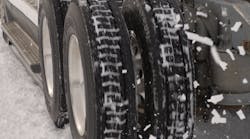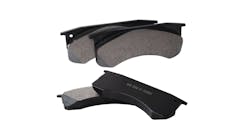The best and brightest fleets are constantly seeking new ways to eliminate inefficiencies in their vehicles, reduce costs and improve their respective bottom lines. To achieve these goals, however, requires them to thoroughly investigate and astutely assess the latest trends and technologies available to determine whether or not they will actually lead to improved performance by their trucks.
One such trend that has risen to prominence in recent years is the 6x2 axle configuration. By switching their tractors to a 6x2 – which consists of a single drive axle with two powered wheels among six total wheel positions – fleets have found a means to cut weight from their vehicles, save fuel and trim costs.
“Fuel costs are a significant operating expense for fleets, and fleets understand that savings in fuel costs go straight to the bottom line,” says Steve Slesinski, director of global product planning, Dana Commercial Vehicle Driveline Technologies, a provider of drivetrain solutions (www.dana.com). “Although diesel prices have been on the decline for some time, forward-looking fleets understand that fuel costs have been trending upward over the long term, so they are taking steps now to maximize the fuel economy of their fleets to prepare for the time when the price of diesel starts to rise again.”
The vast majority of vehicles today still employ the 6x4 axle configuration, which consists of a front steer axle and two rear drive tandem axles connected by a driveshaft, which sends power to both rear axles. The 6x2 varies from that because it is made up of just a single rear drive axle and a second rear tag – also known as a pusher axle or dead axle – eliminating the driveshaft, inter-axle shaft and other components that would connect the rear axles in a 6x4.
THE QUEST FOR FUEL EFFICIENCY
The expected fuel savings gained by switching from a 6x4 configuration to a 6x2 is significant – from 2 to 3 percent says Dana’s Slesinski. This is achieved from a weight savings varying between 350 lbs and 450 lbs and decreases in mechanical drivetrain energy loss.
“This translates into fuel savings of over $1,400 a year for a Class 8 truck logging 120,000 miles at 6.5 mpg,” he adds.
“Very rarely do we find fuel economy technologies that don’t add weight,” says Mike Roeth, executive director, North American Council for Freight Efficiency (NACFE), a council that serves to provide information to help the efficiency of goods movement in North America (www.nacfe.org). “If you are adding skirts or other fuel-saving technologies, there is almost always an addition that adds weight.”
POTENTIAL DISADVANTAGES
While there are many advantages to employing a 6x2 axle configuration, moving away from the 6x4 is not without its drawbacks. These can include reduced torque, reduced traction and increased tire wear.
“These are major concerns for drivers and fleets trying to keep payloads moving through long routes across North America,” says Slesinski of Dana. “That’s why it’s so important to consider duty cycles and truck application.”
According to NACFE’s Roeth, with a 6x2, tires can wear at a higher rate because the vehicle’s torque is going into just one axle. However, he notes that manufacturers are making a concerted effort to respond to that challenge in a couple of different ways. Tire manufacturers are adjusting the design of their offerings to be more readily applicable to 6x2 configurations, while engine, transmission and powertrain manufacturers are limiting torque, particularly at launch.
Proper driver training is also a means to combat the traction concerns that go along with 6x2. Vehicle operators used to driving 6x4 tractors need to be properly trained to allow for the reduced traction supplied by a 6x2.
“Otherwise, they may end up stuck in a situation that would not bring a 6x4 to an unplanned stop,” says Slesinski.
One additional factor that has hindered the widespread acceptance of 6x2s is concern over their potential resale value.
“But there are many factors that play into total cost of ownership – including fuel and maintenance expenses and reduced purchasing costs,” says Slesinski. “All of these things should be considered when configuring a truck, not just resale value.”
TECHNOLOGICAL ADVANCEMENTS
The problem of traction control in vehicles with a 6x2 axle configuration has been alleviated by a number of recent technological advances. For example, an automated air pressure system, when working in concert with electronic controlled air suspension systems, is designed to provide traction by allowing for the transfer of weight to the drive axle for improved low-speed traction.
When a traction event is detected, says Jim Szudy, engineering manager, vehicle systems, Bendix Commercial Vehicle Systems, a developer and supplier of active safety technologies, air brake charging and control systems and components (www.bendix .com), the automated air pressure system exhausts the pressure in the tag axle suspension and increases the pressure in the drive axle suspension to a pre-determined maximum.
“The system works with the ABS/ATC (Automatic Traction Control) system and the vehicle air suspension leveling system to achieve the improved traction,” Szudy adds.
Other technology on the horizon for Class 8 vehicles includes a concept designed to combine the power and performance of a 6x4 with the efficiency of a 6x2. Optimized for trucks that implement engine downspeeding, it allows the vehicle’s tandem axle to operate as a 6x4 with a traditional starting ratio that delivers the optimal tractive effort needed at startup, at low speeds, during backup maneuvering and in other situations where additional traction is deemed necessary.
“As the truck nears highway speed, an electronic control unit (ECU) in the axle coordinates with engine and transmission ECUs to disengage the inter-axle shaft from the power divider, allowing the axle to operate in a more efficient 6x2 mode,” says Dana’s Slesinski. “At the same time, it shifts the forward axle to a faster ratio that enables engine speeds lower than 1,100 rpm for highway cruise operation. This technology is currently undergoing vehicle testing.”
The investment in higher traction tires is also advisable when employing 6x2 configurations, says Slesinski, “keeping in mind that tire tread design will affect vehicle performance and fuel efficiency as well.”
SPEC’ING AND MAINTENANCE DIFFERENCES
Key considerations when comparing 6x2 configurations and 6x4 configurations include the expected duty cycle and lifetime use costs of the vehicle in question, as well as the truck’s application.
“Over-the-road applications in primarily dry weather conditions when torque on all four wheel ends of the tandem axle is not critical will reap the most fuel economy benefits from a 6x2,” says Slesinski of Dana. “Applications where more than 20 percent of time is spent off road, in areas where snow and ice are typical or if the main application is climbing grades versus running on flat ground – a 6x4 configuration would be more efficient.”
If the aforementioned factors are right for a 6x2, fleets can look forward to more benefits – specifically reduced maintenance requirements and lower maintenance costs.
“Since a 6x2 configuration couples a single drive axle with a dead tag axle or pusher axle, in some cases, there is no requirement for an inter-axle shaft and therefore fewer u-joints to lubricate at recommended maintenance intervals,” says Slesinski. “With a single drive axle, there is also less axle lube relative to 6x4 configurations, further reducing maintenance costs.”
According to NACFE’s Roeth, the 6x2 needs less maintenance because there are fewer components. “It doesn’t have gears in the rear or the front. It’s simpler, weighs less and saves fuel,” he says.
As a result, the desire to find new ways to tackle inefficiencies and maximize the value of their vehicles have many fleets strongly considering 6x2 axle configurations.
“There’s no doubt it’s a fuel savings,” says Roeth. “There are issues that make fleets not want to make that jump, but we think it’s worth it.”



